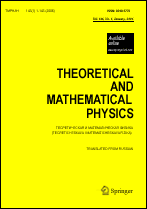|
Can quantum effects due to a massless conformally coupled field avoid gravitational singularities?
J. Haro
Department of Applied Mathematics~I,
Polytechnic University of Catalonia, Barcelona, Spain
Abstract:
Using quantum corrections from massless fields conformally coupled to gravity, we study the possibility of avoiding singularities that appear in the flat Friedmann–Robertson–Walker model. We assume that the universe contains a barotropic perfect fluid with the state equation p=ωρ, where p is the pressure and ρ is the energy density. We study the dynamics of the model for all values of the parameter ω and also for all values of the conformal anomaly coefficients α and β. We show that singularities can be avoided only in the case where α>0 and β<0. To obtain an expanding Friedmann universe at late times with ω>−1 (only a one-parameter family of solutions, but no a general solution, has this behavior at late times), the initial conditions of the nonsingular solutions at early times must be chosen very exactly. These nonsingular solutions consist of a general solution (a two-parameter family) exiting the contracting de Sitter phase and a one-parameter family exiting the contracting Friedmann phase. On the other hand, for ω<−1 (a phantom field), the problem of avoiding singularities is more involved because if we consider an expanding Friedmann phase at early times, then in addition to fine-tuning the initial conditions, we must also fine-tune the parameters α and β to obtain a behavior without future singularities: only a one-parameter family of solutions follows a contracting Friedmann phase at late times, and only a particular solution behaves like a contracting de Sitter universe. The other solutions have future singularities.
Keywords:
cosmological singularity avoidance, semiclassical approximation, conformal anomaly.
Received: 02.02.2011
Revised: 12.04.2011
Citation:
J. Haro, “Can quantum effects due to a massless conformally coupled field avoid gravitational singularities?”, TMF, 171:1 (2012), 162–176; Theoret. and Math. Phys., 171:1 (2012), 563–574
Linking options:
https://www.mathnet.ru/eng/tmf6889https://doi.org/10.4213/tmf6889 https://www.mathnet.ru/eng/tmf/v171/i1/p162
|


| Statistics & downloads: |
| Abstract page: | 386 | | Full-text PDF : | 180 | | References: | 67 | | First page: | 21 |
|




 Contact us:
Contact us: Terms of Use
Terms of Use
 Registration to the website
Registration to the website Logotypes
Logotypes








 Citation in format
Citation in format 